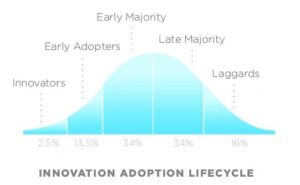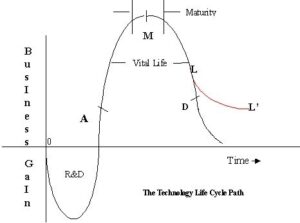Everything has a lifecycle. Sadly, many an intranet’s life has been cut short due to misunderstandings within the organization. With the expectation that an intranet tool should be all things to all people, and that available tools can be a one-size-fits-all, prospects for their longevity grow duller by the minute.
One of the biggest threats to the success of an intranet is that it is often handled by an internal team that is not focused on user experience or product development. As a result, they tend to treat the intranet as a static resource rather than a living driver of organizational culture.
As a result of this, they view the lifecycle along the lines of Roger’s Bell Curve shown below:

Except, that’s the adoption for a tool once it’s released to the world. What’s not accounted for is any pre-launch efforts.
Now, let’s shift gears and take into consideration a standard technological life-cycle.

This is more like it. Look at all that preparation (aka R&D). Unless an organization purchases consultative support or spends the money on a fully customized tool(s), that ‘pre-launch’ work typically falls onto teams that, again, don’t think like product developers. User research, product development, testing and so forth, are not always considered. And many organizations approach launch in this manner, what intranet expert Shel Holz refers to at, “Godspeed.”
The first step in making your employee UX better is in shifting this mindset. Your intranet is not a plug-and-play item that wears out and can be easily replaced. It’s the school, the library, the pressbox, the historical record, the legal protection (or risk), and possibly even the social center of your organization. It’s time to take its presence seriously.
[originally posted on September 22, 2019]
